Interactions between the Built Environment and the Energy-Related Behaviors of Occupants in Government Office Buildings
Abstract
:1. Introduction
2. Investigated Buildings
3. Methods
3.1. User–Building Interaction Model
3.2. Questionnaire
3.3. Field Measurement
4. Results
4.1. Participant Profiles
4.2. Subjective Cognition of Indoor Environment
4.2.1. Importance Level of Different Environmental Factors
4.2.2. Satisfaction Score of Different Environmental Factors
4.3. Influences of Energy-Related Behaviors
4.3.1. Personal Electric Devices
4.3.2. Air Conditioning Habits
4.3.3. Lighting Habits
4.3.4. Ventilation Habits
4.4. Integrated Analysis
4.4.1. Effects of Energy Consumption on Environment Quality
4.4.2. Interactions among Energy-Related Behaviors
5. Discussions
6. Conclusions
Author Contributions
Funding
Institutional Review Board Statement
Informed Consent Statement
Data Availability Statement
Conflicts of Interest
References
- Turner, C.; Frankel, M. Energy performance of LEED for new construction buildings. New Build. Inst. 2008, 4, 1–46. [Google Scholar]
- Newsham, G.R.; Mancini, S.; Birt, B.J. Do LEED-certified buildings save energy? Yes, but…. Energy Build. 2009, 41, 897–905. [Google Scholar] [CrossRef]
- Gill, Z.M.; Tierney, M.J.; Pegg, I.M.; Allan, N. Low-energy dwellings: The contribution of behaviours to actual performance. Build. Res. Inf. 2010, 38, 491–508. [Google Scholar] [CrossRef]
- Clevenger, C.M.; Haymaker, J. The impact of the building occupant on energy modeling simulations. Proceeding of the Joint International Conference on Computing and Decision Making in Civil and Building Engineering, Montreal, QC, Canada, 14–16 June 2006; pp. 1–10. [Google Scholar]
- Sonderegger, R.C. Movers and stayers: The resident’s contribution to variation across houses in energy consumption for space heating. Energy Build. 1978, 1, 313–324. [Google Scholar] [CrossRef] [Green Version]
- Pothitou, M.; Kolios, A.J.; Varga, L.; Gu, S. A framework for targeting household energy savings through habitual behavioral change. Int. J. Sol. Energy 2016, 35, 686–700. [Google Scholar]
- Wood, G.; Newborough, M. Dynamic energy-consumption indicators for domestic appliances: Environment, behavior and design. Energy Build. 2003, 35, 821–841. [Google Scholar] [CrossRef]
- Chung, W. Review of building energy-use performance benchmarking methodologies. Appl. Energy 2011, 88, 1470–1479. [Google Scholar] [CrossRef]
- Roetzel, A.; Tsangrassoulis, U.; Dietrich, S.B. A review of occupant control on natural ventilation. Renew. Sustain. Energy Rev. 2010, 14, 1001–1013. [Google Scholar] [CrossRef]
- Xu, Z.; Jia, Q.; Guan, X. Supply demand coordination for building energy saving. In Proceedings of the IEEE International Conference on Automation Science and Engineering (CASE), Madison, WI, USA, 17–21 August 2013. [Google Scholar]
- Lee, S.; Kwon, B.; Lee, S. Joint energy management system of electric supply and demand in houses and buildings. IEEE Trans. Power Syst. 2014, 29, 2804–2812. [Google Scholar] [CrossRef]
- Al Horr, Y.; Arif, M.; Kaushik, A.; Mazroei, A.; Katafygiotou, M.; Elsarrag, E. Occupant productivity and office indoor environment quality: A review of the literature. Build. Environ. 2016, 105, 369–389. [Google Scholar] [CrossRef] [Green Version]
- Yang, L.; Yan, H.; Lam, J.C. Thermal comfort and building energy consumption implications—A review. Appl. Energy 2014, 115, 164–173. [Google Scholar] [CrossRef]
- O’Brien, W.; Gunay, H.B. The contextual factors contributing to occupants’ adaptive comfort behaviors in offices—A review and proposed modeling framework. Build. Environ. 2014, 77, 77–87. [Google Scholar] [CrossRef]
- Stazi, F.; Naspi, F.; D’Orazio, M. A literature review on driving factors and contextual events influencing occupants’ behaviours in buildings. Build. Environ. 2017, 118, 40–66. [Google Scholar] [CrossRef]
- Fabi, V.; Andersen, R.V.; Corgnati, S.; Olesen, B.W. Occupants’ window opening behaviour: A literature review of factors influencing occupant behavior and models. Build. Environ. 2012, 58, 188–198. [Google Scholar] [CrossRef]
- Pisello, A.L.; Castaldo, V.L.; Piselli, C. How peers’ personal attitudes affect indoor microclimate and energy need in an institutional building: Results from a continuous monitoring campaign in summer and winter conditions. Energy Build. 2016, 126, 485–497. [Google Scholar] [CrossRef]
- Vuarnoz, D.; Hoxha, E.; Nembrini, J.; Jusselme, T.; Cozza, S. Assessing the gap between a normative and a reality-based model of building LCA. J. Build. Eng. 2020, 31, 101454. [Google Scholar] [CrossRef]
- Li, Q.; Sun, X.; Chen, C.; Yang, X. Characterizing the household energy consumption in heritage Nanjing Tulou buildings, China: A comparative field survey study. Energy Build. 2012, 49, 317–326. [Google Scholar] [CrossRef]
- Jiang, P.; Chen, Y.; Xu, B.; Dong, W.; Kennedy, E. Building low carbon communities in China: The role of individual’s behaviour change and engagement. Energy Policy 2013, 60, 611–620. [Google Scholar] [CrossRef]
- Hu, S.; Yan, D.; Guo, S.; Cui, Y.; Dong, B. A survey on energy consumption and energy usage behavior of households and residential building in urban China. Energy Build. 2017, 148, 366–378. [Google Scholar] [CrossRef]
- De Dear, R.J.; Brager, G.S. Thermal comfort in naturally ventilated buildings: Revisions to ASHRAE standard 55. Energy Build. 2002, 34, 549–561. [Google Scholar] [CrossRef] [Green Version]
- Liu, L.; Zhao, J.; Liu, X.; Wang, Z. Energy consumption comparison analysis of high energy efficiency office buildings in typical climate zones of China and U.S. based on correction model. Energy 2013, 65, 221–232. [Google Scholar] [CrossRef]
- Li, Y.Y.; Guo, K.; Du, R.; Li, H.C.; Yang, Y.G. The studies on the energy consumption quota of state organ office buildings. Adv. Mater. Res. 2011, 243–249, 5899–5904. [Google Scholar] [CrossRef]
- Ministry of Housing and Urban Rural Development of the People’s Republic of China. GB/T 51161-2016. Standard for Energy Consumption of Building; Ministry of Housing and Urban Rural Development of the People’s Republic of China: Beijing, China, 2016.
- Von Grabe, J. Decision models and data in human-building interactions. Energy Res. Soc. Sci. 2016, 19, 61–65. [Google Scholar] [CrossRef]
- Wang, J.; Wang, Z.; Dear, R.D.; Luo, M.; Ghahramani, A.; Lin, B. The uncertainty of subjective thermal comfort measurement. Energy Build. 2018, 181, 38–49. [Google Scholar] [CrossRef]
- Wang, Z.; Zhang, H.; He, Y.; Luo, M.; Li, Z.; Hong, T.; Lin, B. Revisiting individual and group differences in thermal comfort based on ASHRAE database. Energy Build. 2020, 219, 110017. [Google Scholar] [CrossRef]
- Oakland, G.B. Determining sample size. Can. Entomol. 1953, 85, 108–113. [Google Scholar] [CrossRef]
- Kraus, M.; Senitkova, I.J. A study of perceived air quality and odours. IOP Conf. Series Mater. Sci. Eng. 2019, 471, 092004. [Google Scholar] [CrossRef]
- Erdmann, C.A.; Apte, M.G. Mucous membrane and lower respiratory building related symptoms in relation to indoor carbon dioxide concentrations in the 100-building BASE dataset. Indoor Air 2004, 14, 127–134. [Google Scholar] [CrossRef] [PubMed]
- Federspiel, C.C.; Fisk, W.J.; Price, P.N.; Liu, G.; Faulkner, D.; Dibartolomeo, D.L.; Sullivan, D.P.; Lahiff, M. Worker performance and ventilation in a call center: Analyses of work performance data for registered nurses. Indoor Air 2010, 14, 41–50. [Google Scholar] [CrossRef] [PubMed] [Green Version]
- Ministry of Housing and Urban Rural Development of the People’s Republic of China. JGJ/T 177-2009. Standard for Energy Efficiency Test of Public Buildings; Ministry of Housing and Urban Rural Development of the People’s Republic of China: Beijing, China, 2009.
- Ministry of Housing and Urban Rural Development of the People’s Republic of China; General Administration of Quality Supervision, Inspection and Quarantine of the People’s Republic of China. GB 50736-2012. Design Code for Heating Ventilation and Air Conditioning of Civil Buildings; Ministry of Housing and Urban Rural Development of the People’s Republic of China; General Administration of Quality Supervision, Inspection and Quarantine of the People’s Republic of China: Beijing, China; Beijing, China, 2012.
- General Administration of Quality Supervision, Inspection and Quarantine of the People’s Republic of China. GB/T 18204.24-2000. Methods for Determination of Carbon Dioxide in Air of Public Places; General Administration of Quality Supervision, Inspection and Quarantine of the People’s Republic of China: Beijing, China, 2000.
- General Administration of Quality Supervision, Inspection and Quarantine of the People’s Republic of China; National Health Commission of the People’s Republic of China; Ministry of Ecology and Environment of the People’s Republic of China. GB/T 18883-2002. Indoor Air Quality Standard; Standards Press of China: Beijing, China, 2002.
- General Administration of Quality Supervision, Inspection and Quarantine of the People’s Republic of China; Standardization Administration of the People’s Republic of China. GB/T 5700-2008. Measurement Methods for Lighting; General Administration of Quality Supervision, Inspection and Quarantine of the People’s Republic of China; Standardization Administration of the People’s Republic of China: Beijing, China; Beijing, China, 2008.
- Ministry of Housing and Urban Rural Development of the People’s Republic of China; General Administration of Quality Supervision, Inspection and Quarantine of the People’s Republic of China. GB 50034-2013. Standard for Lighting Design of Buildings; Ministry of Housing and Urban Rural Development of the People’s Republic of China; General Administration of Quality Supervision, Inspection and Quarantine of the People’s Republic of China: Beijing, China; Beijing, China, 2013.
- Ministry of Housing and Urban Rural Development of the People’s Republic of China; General Administration of Quality Supervision, Inspection and Quarantine of the People’s Republic of China. GB 50118-2010. Code for Design of Sound Insulation of Civil Buildings; Ministry of Housing and Urban Rural Development of the People’s Republic of China; General Administration of Quality Supervision, Inspection and Quarantine of the People’s Republic of China: Beijing, China; Beijing, China, 2010.
- Von dem Knesebeck, O.; Vonneilich, N.; Kim, T.J. Public awareness of poverty as a determinant of health: Survey results from 23 countries. Int. J. Public Health 2018, 63, 165–172. [Google Scholar] [CrossRef] [PubMed]
- Zhu, X.; Lv, M.; Yang, X. Performance of sorption-based portable air cleaners in formaldehyde removal: Laboratory tests and field verification. Build. Environ. 2018, 136, 177–184. [Google Scholar] [CrossRef]
- Omrany, H.; Soebarto, V.; Zuo, J.; Sharifi, E.; Chang, R. What leads to variations in the results of life-cycle energy assessment? An evidence-based framework for residential buildings. Energy Built Environ. 2021, 2, 392–405. [Google Scholar] [CrossRef]
- Keyvanfar, A.; Shafaghat, M.Z.; Majid, A.; Lamit, H.B.; Hussin, M.W.; Ali, K.N.B.; Saad, A.D. User satisfaction adaptive behaviors for assessing energy efficient building indoor cooling and lighting environment. Renew. Sustain. Energy Rev. 2014, 39, 277–295. [Google Scholar] [CrossRef]
- Lee, W.L.; Yik, F.; Jones, P.; Burnett, J. Energy saving by realistic design data for commercial buildings in Hong Kong. Appl. Energy 2001, 70, 59–75. [Google Scholar] [CrossRef]
- Yu, P.C.; Chow, W.K. A discussion on potentials of saving energy use for commercial buildings in Hong Kong. Energy 2007, 32, 83–94. [Google Scholar] [CrossRef]
- Sintov, N.D.; Schultz, P.W. Adjustable green defaults can help make smart homes more sustainable. Sustainability 2017, 9, 622. [Google Scholar] [CrossRef] [Green Version]
- Pan, S.; Xie, L.; Wei, S.; Wang, Y.; Xu, C.; Wang, X.; Zhang, Y. A review of building occupants adaptive behavior in buildings of China. In Proceedings of the 5th International Conference on Civil Engineering and Transportation, Guangzhou, China, 28–29 November 2015; Volume 30, pp. 1528–1531. [Google Scholar]
- Luo, M.; Yu, J.; Ouyang, Q.; Cao, B.; Zhu, Y. Application of dynamic airflows in buildings and its effects on perceived thermal comfort. Indoor Built Environ. 2017, 27, 1162–1174. [Google Scholar] [CrossRef]
- Deuble, M.P.; de Dear, R.J. Green occupants for green buildings: The missing link? Build. Environ. 2012, 56, 21–27. [Google Scholar] [CrossRef]
- Xie, X.; Lu, Y.; Gou, Z. Green building pro-environment behaviors: Are green users also green buyers? Sustainability 2017, 9, 1703. [Google Scholar] [CrossRef] [Green Version]
- Geng, Y.; Yu, J.; Lin, B.; Wang, Z.; Huang, Y. Impact of individual IEQ factors on passengers’ overall satisfaction in Chinese airport terminals. Build. Environ. 2017, 112, 241–249. [Google Scholar] [CrossRef]
- Geng, Y.; Ji, W.; Lin, B.; Zhu, Y. The impact of thermal environment on occupant IEQ perception and productivity. Build. Environ. 2017, 121, 158–167. [Google Scholar] [CrossRef]
- Hong, T.; D’Oca, S.; Turner, W.J.; Taylor-Lange, S.C. An ontology to represent energy-related occupant behavior in buildings. Part I: Introduction to the DNAs framework. Build. Environ. 2015, 92, 764–777. [Google Scholar] [CrossRef] [Green Version]
- Hong, T.; D’Oca, S.; Taylor-Lange, S.C.; Turner, W.J.; Chen, Y.; Corgnati, S.P. An ontology to represent energy-related occupant behavior in buildings. Part II: Implementation of the DNAS framework using an XML schema. Build. Environ. 2015, 94, 196–205. [Google Scholar] [CrossRef] [Green Version]


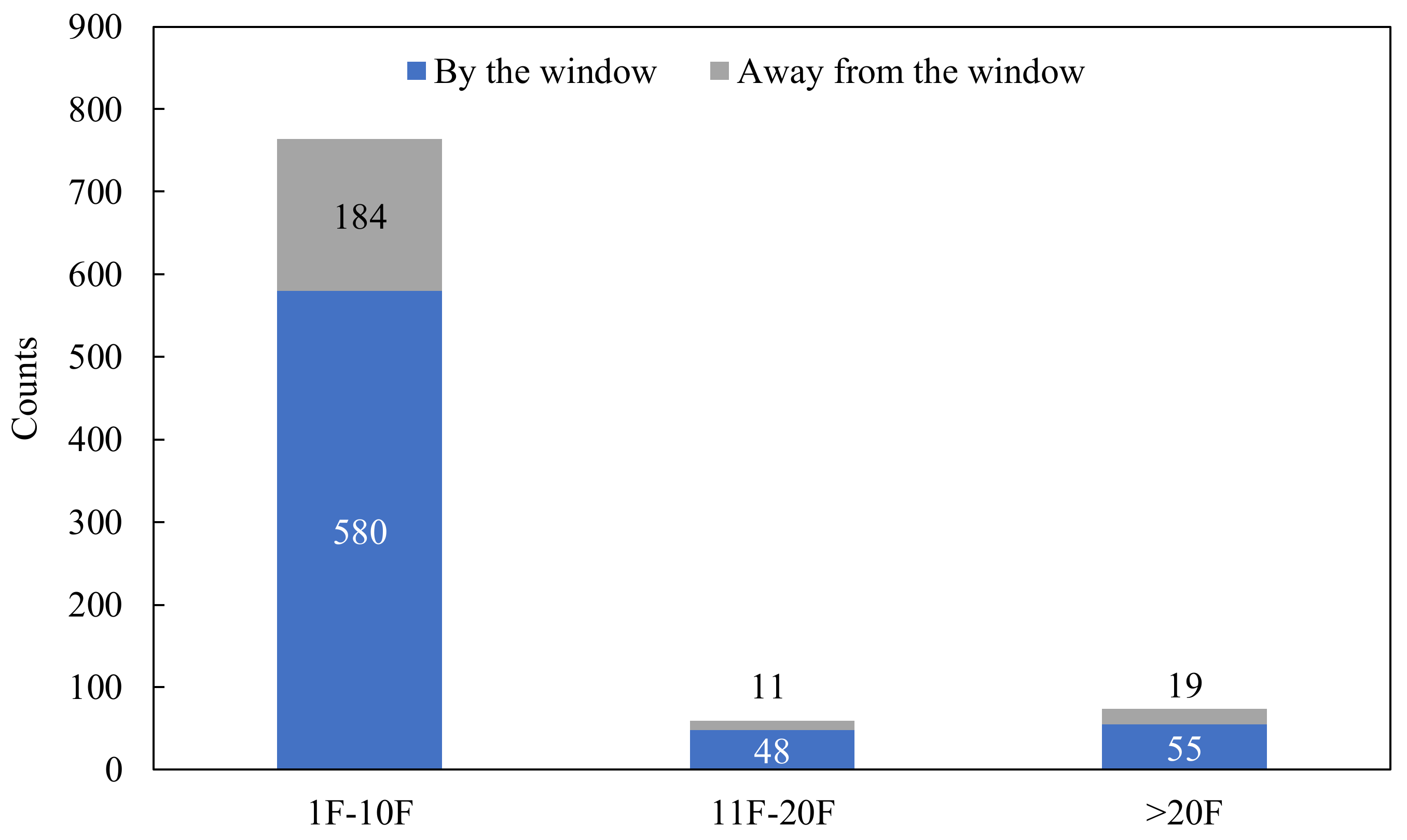

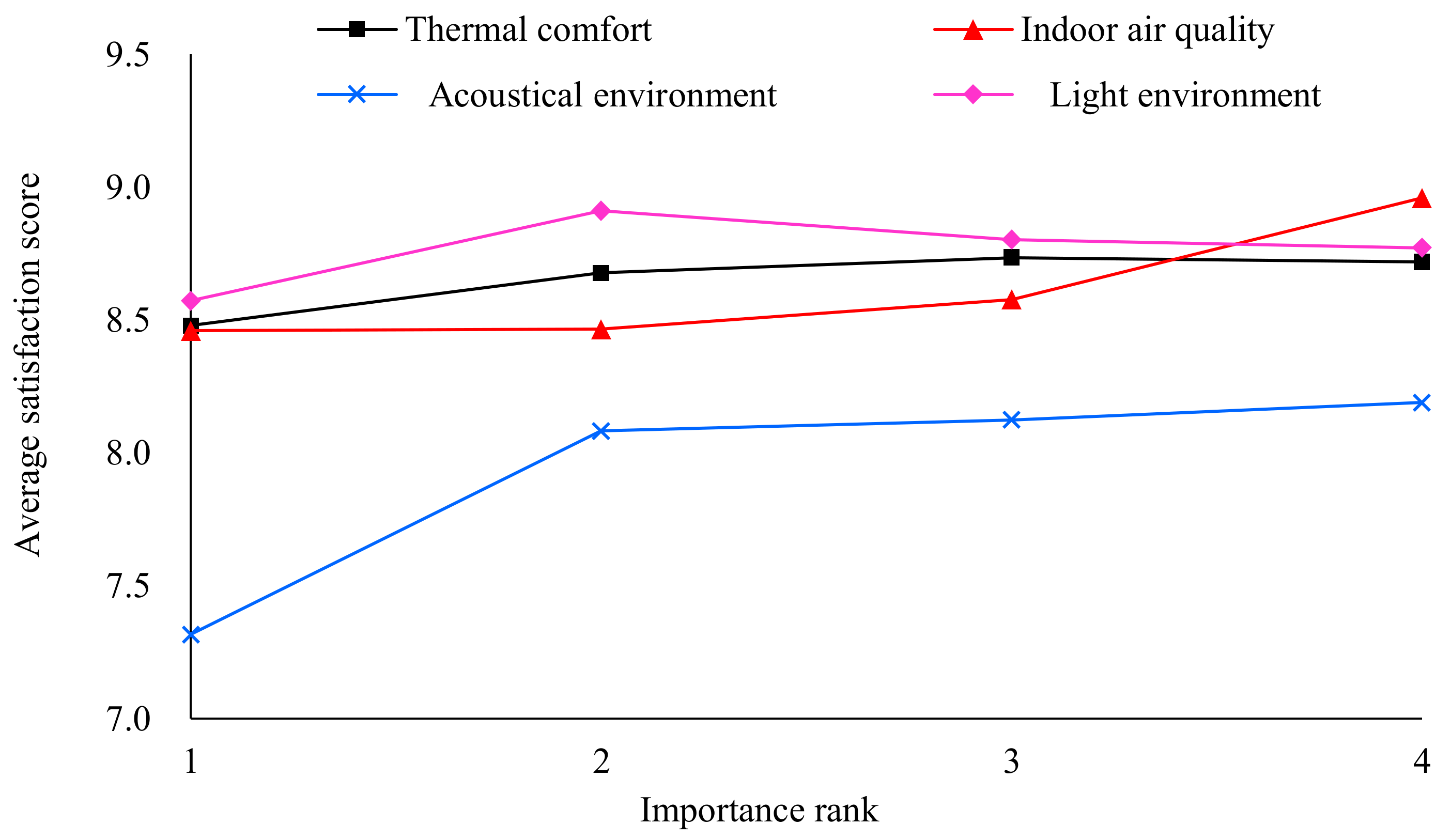
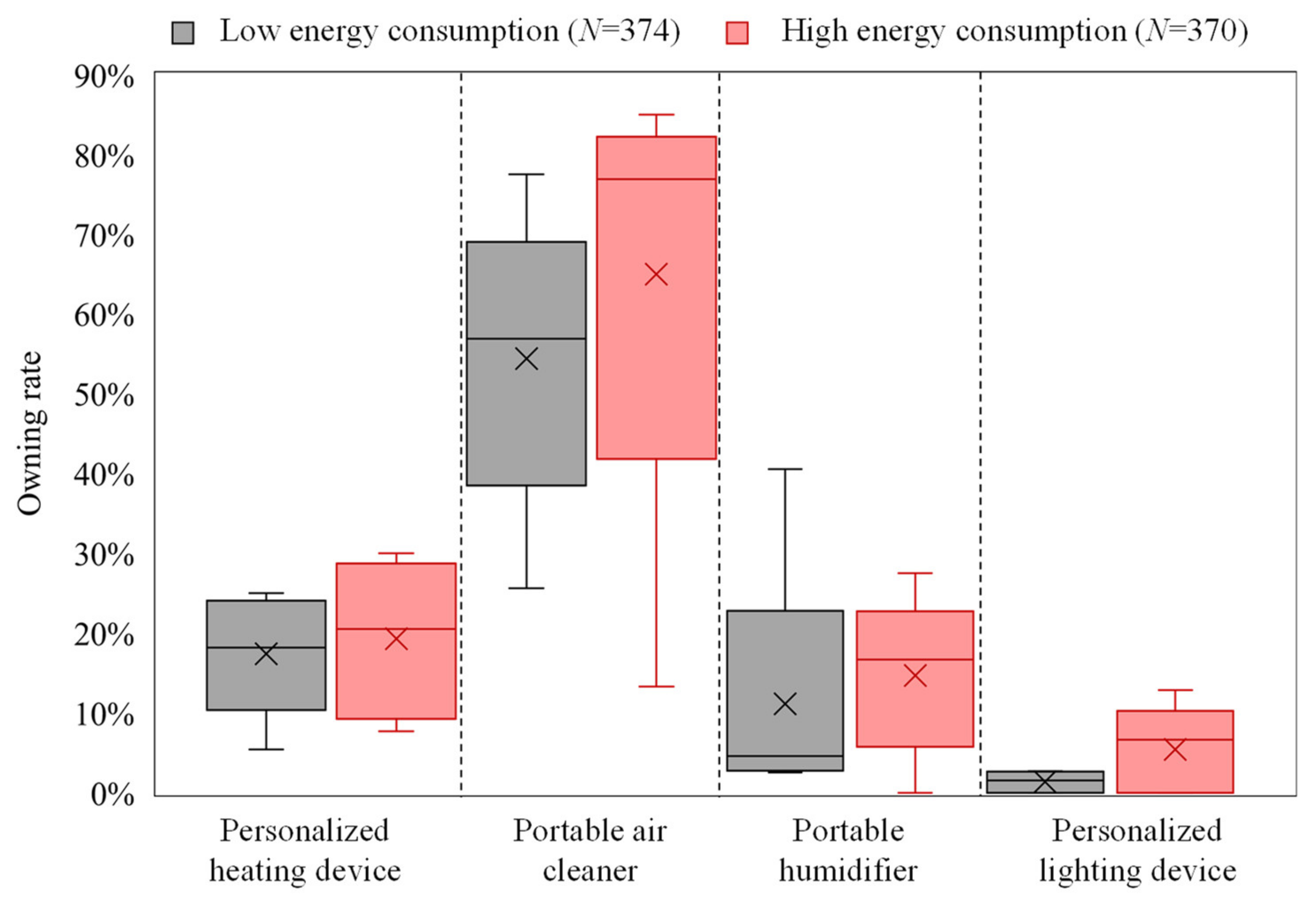

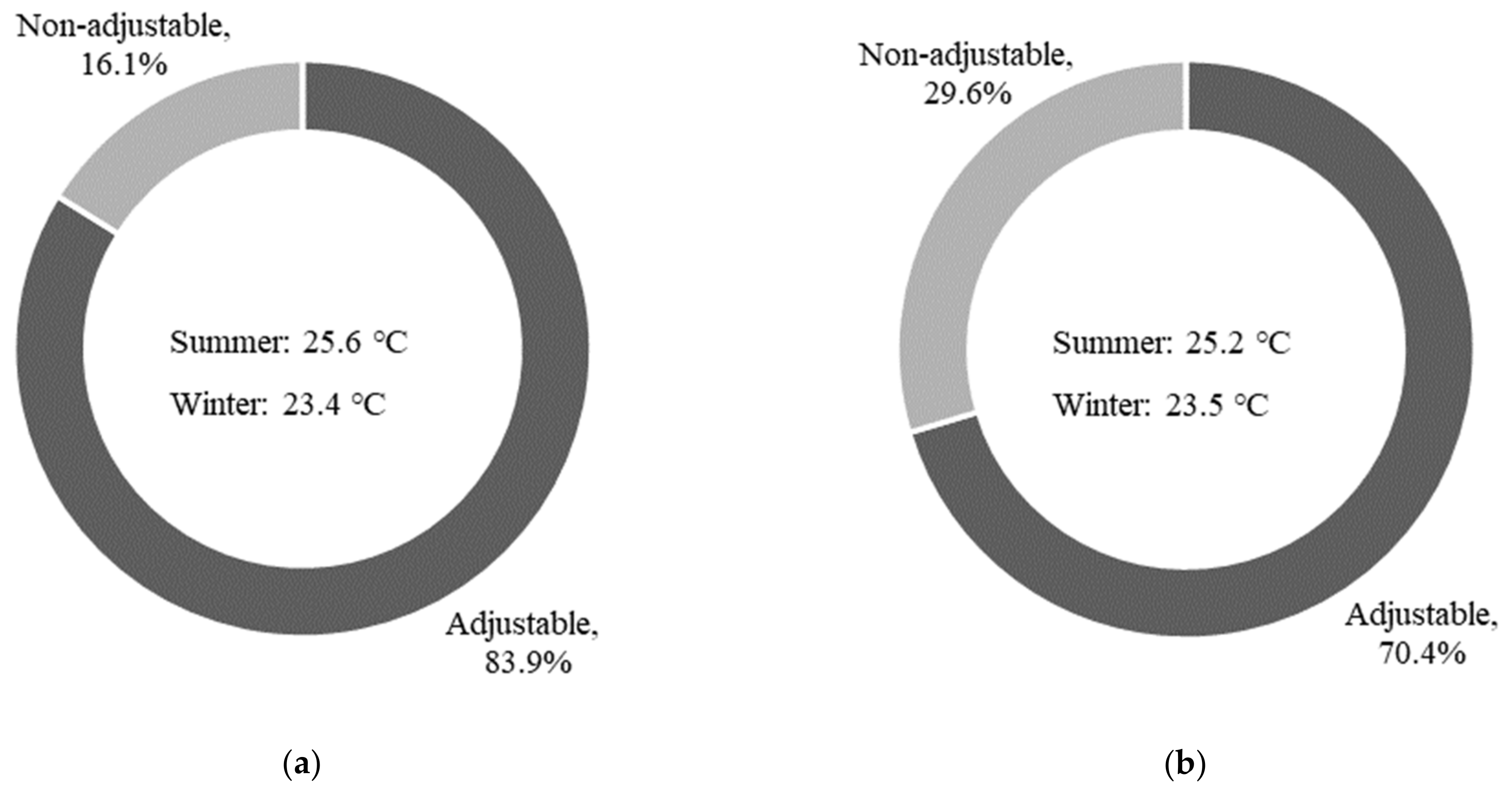

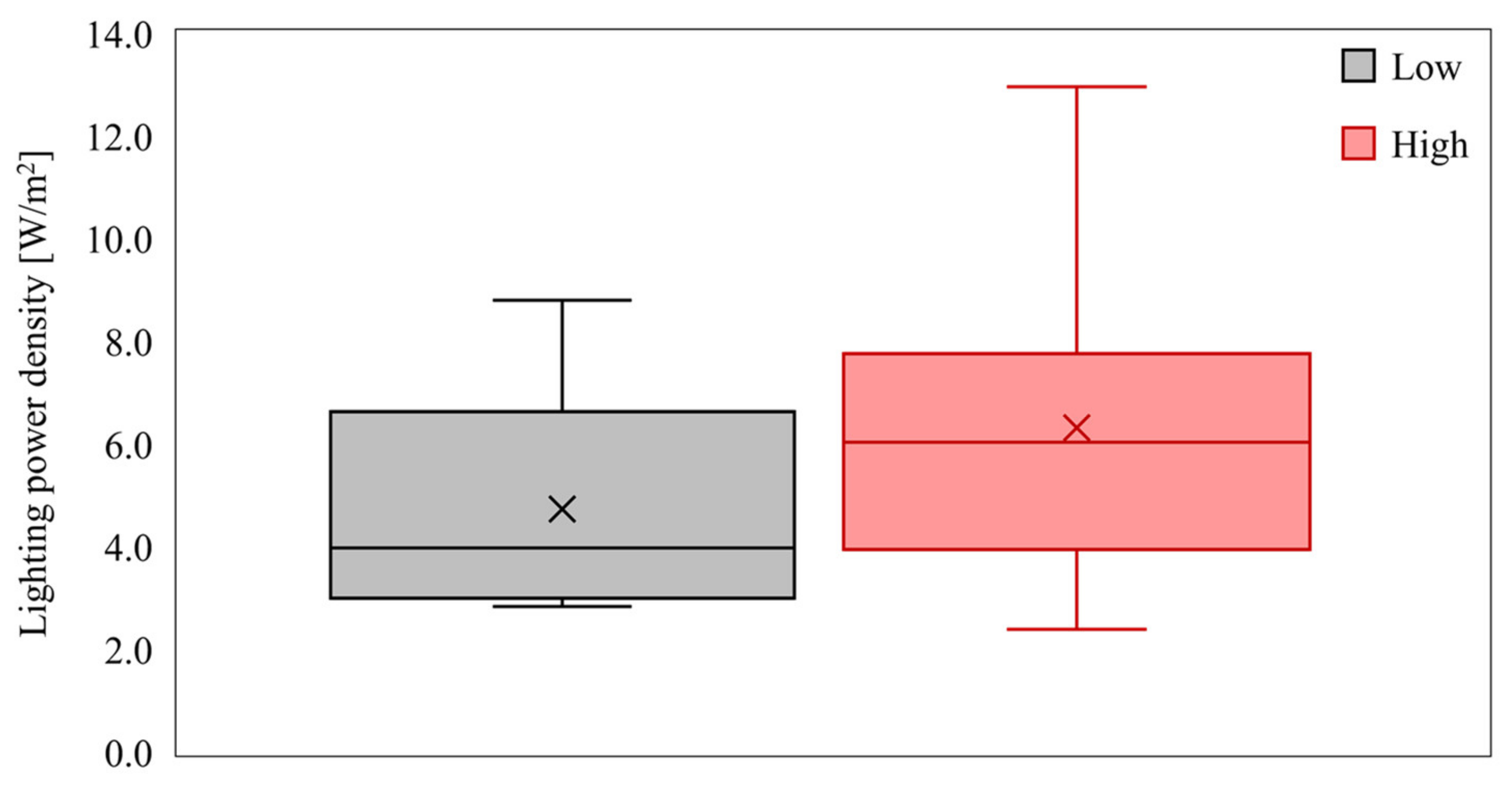
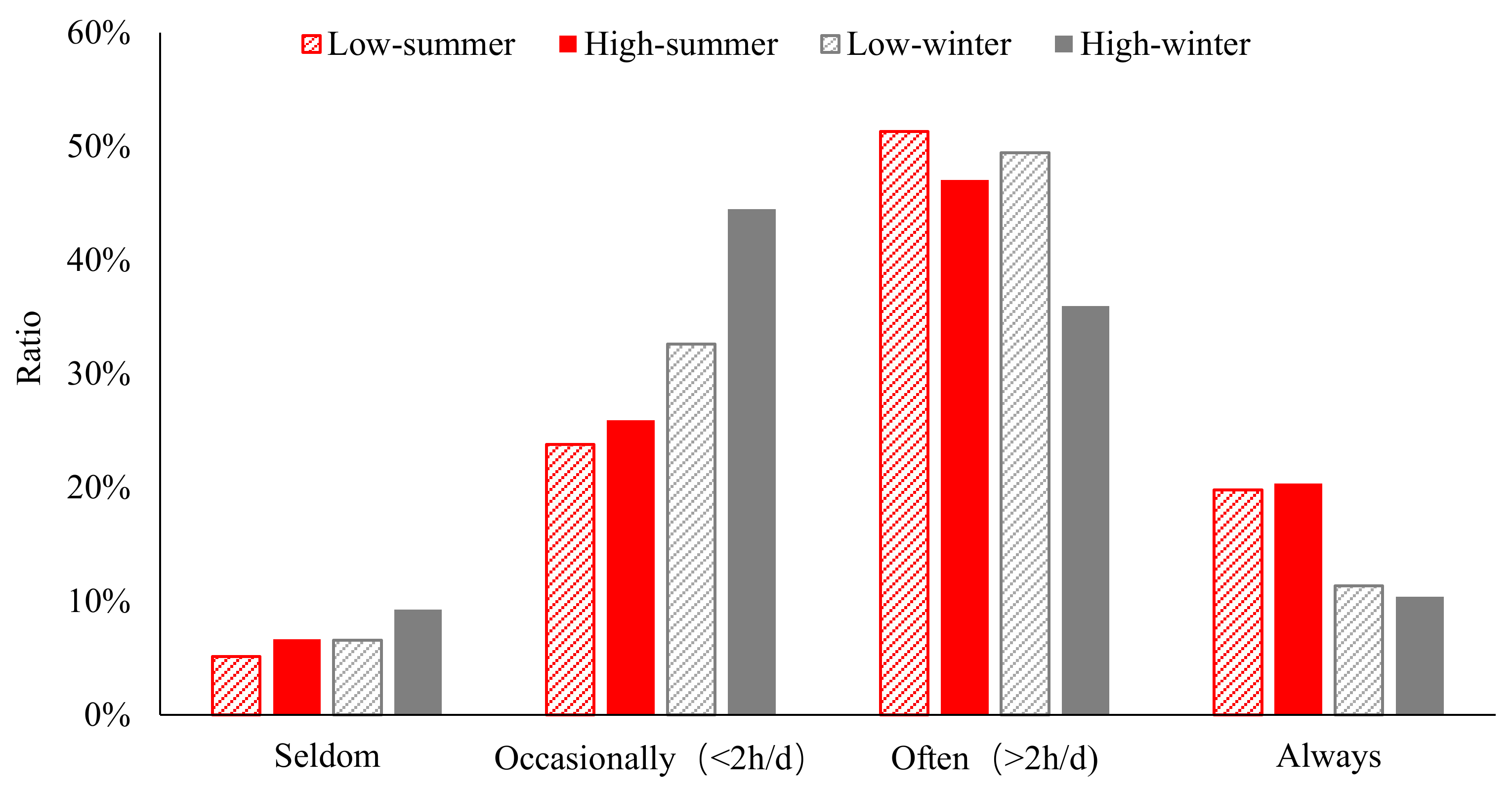
| No. | Completion Year | Number of Staff | Floor | Floor Area (m2) | Insulation | Window Glass | Air Conditioning System | * E (kWh/(m2·a)) | Adjusted E (kWh/(m2·a)) |
|---|---|---|---|---|---|---|---|---|---|
| 1 | 1995 | 786 | 32/-1F | 49,290 | None | Low-E hollow glass | Electric chiller | 70.5 | 181.7 |
| 2 | 1995 | 371 | 17/-1F | 21,818 | Roof | Low-E hollow glass | Electric chiller | 59.6 | 146.8 |
| 3 | 1997 | 184 | 14/-1F | 11,189 | None | Double silver Low-E hollow glass | Split air conditioner | 36.1 | 91.1 |
| 4 | 2002 | 164 | 11/-1F | 10,020 | Roof | Low-E hollow glass | Split air conditioner | 51.6 | 130.6 |
| 5 | 2011 | 131 | 12F | 13,099 | Wall and roof | Low-E hollow glass | VRV air conditioner | 66.9 | 247.4 |
| 6 | 2011 | 169 | 6F | 11,613 | Wall and roof | Insulating glass | Air-cooled heat pump | 52.1 | 143.8 |
| 7 | 2005 | 116 | 9/-1F | 9250 | Roof | Low-E hollow glass | Air-cooled heat pump | 62.2 | 192.2 |
| 8 | 1998 | 190 | 10/-1F | 15,869 | Roof | Transparent glass | Air-cooled heat pump | 36.4 | 116.6 |
| 9 | 2011 | 277 | 9/-1F | 17,584 | Wall and roof | Low-E hollow glass | Air-cooled heat pump | 53.9 | 140.3 |
| 10 | 2010 | 175 | 10/-1F | 11,510 | Wall and roof | Low-E hollow glass | Air-cooled heat pump | 63.9 | 170.8 |
| 11 | 2003 | 190 | 12/-1F | 10,785 | Roof | Insulating glass | Split air conditioner | 60.7 | 145.7 |
| 12 | 1991 | 258 | 7F | 8640 | Roof | Transparent glass | Split air conditioner | 50.2 | 85.4 |
| 13 | 1997 | 202 | 19/-1F | 22,218 | Roof | Transparent glass | VRV air conditioner | 34.5 | 138.1 |
| 14 | 2003 | 205 | 15F | 22,278 | None | Transparent glass | Air-cooled heat pump | 27.7 | 109.6 |
| 15 | 2003 | 198 | 8/-1F | 17,000 | Roof | Transparent glass | Air-cooled heat pump | 28.1 | 91.9 |
| 16 | 2010 | 220 | 7/-1F | 11,479 | Wall and roof | Low-E hollow glass | Air-cooled heat pump | 60.7 | 137.4 |
| 17 | 1999 | 269 | 14/-1F | 15,449 | None | Low-E hollow glass | Split air conditioner | 32.8 | 79.4 |
| 18 | 2005 | 198 | 9/-1F | 10,850 | Roof | Insulating glass | Air-cooled heat pump | 59.3 | 139.0 |
| 19 | 1997 | 151 | 11/-1F | 13,371 | None | Low-E hollow glass | Split air conditioner | 37.6 | 126.1 |
| 20 | 1995 | 127 | 8F | 5007 | None | Transparent glass | Split air conditioner | 51.1 | 96.3 |
| 21 | 2004 | 168 | 10/-1F | 11,857 | None | Insulating glass | Split air conditioner | 60.0 | 168.9 |
| 22 | 2007 | 250 | 8F | 9124 | Roof | Transparent glass | Air-cooled heat pump | 56.2 | 100.9 |
| Part 1 Basic information |
| 1. Please fill in your affiliation. (Fill in the blank) |
| 2. On which floor is your office located? (Fill in the blank) |
| 3. Is your seat by the window? (Yes/No) |
| 4. Please choose the working mode closest to the actual situation. |
| A. Fixed working hours and little outwork |
| B. Fluctuating working hours and little outwork |
| C. Frequent outwork, and the number of staff in the office varies greatly every day |
| D. Other |
| 5. Please fill in the percentage of weekends that you work overtime in a year. |
| Part 2 Evaluation of indoor environment |
| 6. Please rank the following aspects of indoor environment in the order of importance. (1: Most important; 4: least important) |
| A. Thermal comfort; B. indoor air quality; C. acoustic environment; D. lighting environment |
| 7. Please rate your satisfaction with the current office environment. (0: Totally dissatisfied; 10: fully satisfied) |
A. Thermal comfort: |
B. Indoor air quality: |
C. Acoustic environment: |
D. Lighting environment: |
| 8. Please fill in specific indoor environment improvement suggestions. |
| Part 3 Energy-related behaviors |
| 9. Please choose the air conditioning pattern closest to the actual situation. (Answer the question separately for summer and winter) |
| A. Turn on: at arrival; turn off: at the end of work |
| B. Turn on: at arrival; turn off: after establishing thermal comfort. |
| C. Turn on: feeling thermal discomfort; turn off: after establishing thermal comfort. |
| D. Barely use air conditioners. |
| E. Other |
| 10. Please fill in the air conditioner setting temperature. (SummerWinter) |
| 11. Is the setting temperature adjustable? (Yes/No) |
| 12. Do you use personalized devices for thermal comfort in addition to the air conditioner (e.g., humidifier, desktop fan, electric heater)? (Yes/No) |
| 13. Do you use portable air cleaners in your office? (Yes/No) |
| 14. Do you use a desk lamp? (Yes/No) |
| 15. Please choose the window-opening pattern closest to your actual habits. (Answer the question separately for summer and winter) |
| A. Barely open/unopenable window (≈0 h/day) |
| B. Occasionally (<2 h/day) |
| C. Usually (>2 h/day) |
| D. Windows are normally open (≈24 h/day) |
| 16. Please choose the lighting pattern closest to your actual habits. |
| A. Turn on: at arrival; turn off: at the end of work; area: all lights |
| B. Turn on: at arrival; turn off: when people leave the room; area: all lights |
| C. Turn on: at arrival; turn off: when people leave the room; area: only in places with people |
| D. Lighting system is automatically controlled. |
| E. Other |
| Parameter | Test Standard | Limit Value | Measuring Instrument | Instrument Performance |
|---|---|---|---|---|
| Air temperature and relative humidity | JGJ/T 177-2009 [33] | Summer: 24–26 °C, 40–60%; Winter: 16–22 °C, ≥30% [34] | Temperature and humidity recorder (L95-2, Hangzhou Loggertech Co., Ltd., Hangzhou, China) | Range: −40–+100 °C, 0–100% Accuracy: ±0.5 °C, ±3% |
| CO2 | GB/T 18204.24-2000 [35] | <1000 ppm [36] | Infrared carbon dioxide monitor (TEL 7001, General Electric Company, Boston, MA, USA) | Range: 0–10,000 ppm Accuracy: ±5% |
| Illuminance | GB/T 5700-2008 [37] | ≥300 Lux [38] | Handheld illuminance meter (FLUKE 941, FLUKE Co., Ltd., Everett, DC, USA) | Range: 20–200,000 Lux Accuracy: ±3% |
| A-weighted sound pressure level of noise | GB 50118-2010 [39] | ≤45 dB(A) [40] | Multifunction sound level meter (AWA6228+, Hangzhou AiHua Intelligent Technology Co., Ltd., Hangzhou, China) | Range: 20–132 dB(A) Accuracy: ±3% |
| Environmental Factors | Importance Rank | Average Importance Rank | |||
|---|---|---|---|---|---|
| 1 | 2 | 3 | 4 | ||
| Thermal comfort | 24.7% | 30.1% | 19.9% | 25.4% | 2.46 |
| Indoor air quality | 67.5% | 22.8% | 7.0% | 2.7% | 1.45 |
| Acoustic environment | 4.8% | 22.5% | 38.5% | 34.3% | 3.02 |
| Light environment | 8.8% | 24.0% | 37.8% | 29.5% | 2.88 |
| Environmental Factors | Satisfaction Score | Average Satisfaction Score | |||
|---|---|---|---|---|---|
| <3 | [3,6) | [6,8) | >8 | ||
| Thermal comfort | 1.1% | 3.0% | 18.4% | 77.4% | 8.8 |
| Indoor air quality | 1.3% | 5.1% | 21.4% | 72.3% | 8.6 |
| Acoustic environment | 3.1% | 9.0% | 25.0% | 62.9% | 8.2 |
| Light environment | 1.0% | 4.2% | 15.7% | 79.1% | 9.0 |
| Parameters | High-Energy-Consuming Buildings | Low-Energy-Consuming Buildings | |
|---|---|---|---|
| Air temperature (winter) (°C) | Min | 15.4 | 11.3 |
| Max | 25.1 | 30.2 | |
| Average | 19.8 | 20.4 | |
| Average compliance rate | 80.6% | 71.3% | |
| Relative humidity (winter) (%) | Min | 25.8 | 18.5 |
| Max | 57.2 | 64.7 | |
| Average | 42.7 | 40.5 | |
| Average compliance rate | 84.0% | 89.0% | |
| CO2 concentration (ppm) | Max | 996.9 | 875.1 |
| Average | 622.1 | 580.1 | |
| Average compliance rate | 100.0% | 100.0% | |
| A-weighted sound pressure level of noise (dB(A)) | Max | 55 | 58 |
| Average | 44 | 46 | |
| Average compliance rate | 66.6% | 47.4% | |
| Illuminance (l×) | Min | 105.7 | 81.0 |
| Average | 265.3 | 303.0 | |
| Average compliance rate | 30.4% | 18.7% | |
| Average satisfaction score | Thermal comfort | 8.76 | 8.83 |
| Indoor air quality | 8.73 | 8.56 | |
| Acoustic environment | 8.41 | 8.03 | |
| Light environment | 8.85 | 8.89 | |
| Air Conditioning Habit (Winter) | Lighting Habit | E | ||||||||
|---|---|---|---|---|---|---|---|---|---|---|
| Waste | Neutral | Good | Economical | Waste | Neutral | Good | Economical | |||
| Air conditioning habit (summer) | Waste | 0.736 ** | 0.266 | −0.540 * | −0.316 | 0.250 | 0.153 | −0.212 | −0.080 | 0.29 |
| Neutral | 0.041 | 0.233 | −0.399 | 0.084 | −0.331 | 0.025 | 0.169 | −0.358 | 0.27 | |
| Good | −0.517 * | −0.431 | 0.664 ** | 0.184 | −0.126 | −0.127 | 0.056 | 0.185 | −0.15 | |
| Economical | −0.327 | 0.339 | −−0.149 | 0.246 | −0.537 * | −0.071 | 0.243 | 0.206 | −0.28 | |
| Lighting habit | Window-opening habit (winter) | E | ||||||||
| Waste | Neutral | Good | Economical | Seldom | Occasional | Often | Always | |||
| Air conditioning habit (winter) | Waste | 0.471 | 0.113 | −0.325 | −0.179 | 0.295 | 0.372 | −0.303 | −0.233 | 0.02 |
| Neutral | −0.111 | −0.271 | 0.276 | 0.301 | 0.577 * | 0.187 | −0.324 | −0.262 | 0.10 | |
| Good | −0.503 * | 0.191 | 0.271 | 0.092 | −0.300 | −0.060 | 0.253 | −0.172 | −0.08 | |
| Economical | −0.636 ** | −0.085 | 0.282 | 0.159 | −0.333 | −0.321 | 0.179 | 0.512 * | −0.06 | |
| Window-opening habit (summer) | Window-opening habit (winter) | E | ||||||||
| Seldom | Occasional | Often | Always | Seldom | Occasional | Often | Always | |||
| Lighting habit | Waste | 0.194 | −0.021 | −0.287 | 0.045 | −0.152 | −0.021 | 0.192 | −0.055 | 0.17 |
| Neutral | 0.009 | −0.221 | −0.135 | 0.336 | −0.121 | −0.167 | 0.144 | 0.096 | 0.20 | |
| Good | −0.098 | 0.044 | 0.315 | −0.265 | 0.078 | 0.029 | −0.082 | −0.003 | −0.03 | |
| Economical | 0.243 | 0.530 * | −0.150 | −0.557 * | 0.465 | 0.526 * | −0.563 * | −0.360 | −0.70 ** | |
| Window-opening habit (winter) | E | |||||||||
| Seldom | Occasional | Often | Always | |||||||
| Window-opening habit (summer) | Seldom | 0.840 ** | 0.172 | −0.464 | −0.283 | 0.06 | ||||
| Occasional | 0.114 | 0.663 ** | −0.544 * | −0.362 | 0.44 | |||||
| Often | −0.318 | −0.511 * | 0.558 * | 0.268 | −0.25 | |||||
| Always | −0.397 | −0.443 | 0.442 | 0.507 * | −0.22 | |||||
Publisher’s Note: MDPI stays neutral with regard to jurisdictional claims in published maps and institutional affiliations. |
© 2021 by the authors. Licensee MDPI, Basel, Switzerland. This article is an open access article distributed under the terms and conditions of the Creative Commons Attribution (CC BY) license (https://creativecommons.org/licenses/by/4.0/).
Share and Cite
Zhu, X.; Gao, B.; Yang, X.; Yuan, Y.; Ni, J. Interactions between the Built Environment and the Energy-Related Behaviors of Occupants in Government Office Buildings. Sustainability 2021, 13, 10607. https://doi.org/10.3390/su131910607
Zhu X, Gao B, Yang X, Yuan Y, Ni J. Interactions between the Built Environment and the Energy-Related Behaviors of Occupants in Government Office Buildings. Sustainability. 2021; 13(19):10607. https://doi.org/10.3390/su131910607
Chicago/Turabian StyleZhu, Xiaoyue, Bo Gao, Xudong Yang, Yanping Yuan, and Ji Ni. 2021. "Interactions between the Built Environment and the Energy-Related Behaviors of Occupants in Government Office Buildings" Sustainability 13, no. 19: 10607. https://doi.org/10.3390/su131910607
APA StyleZhu, X., Gao, B., Yang, X., Yuan, Y., & Ni, J. (2021). Interactions between the Built Environment and the Energy-Related Behaviors of Occupants in Government Office Buildings. Sustainability, 13(19), 10607. https://doi.org/10.3390/su131910607







